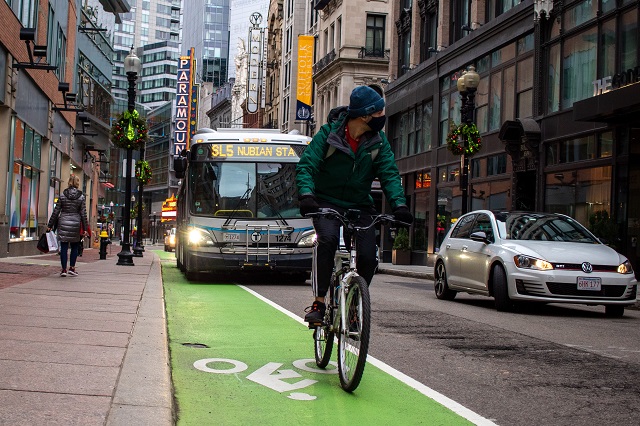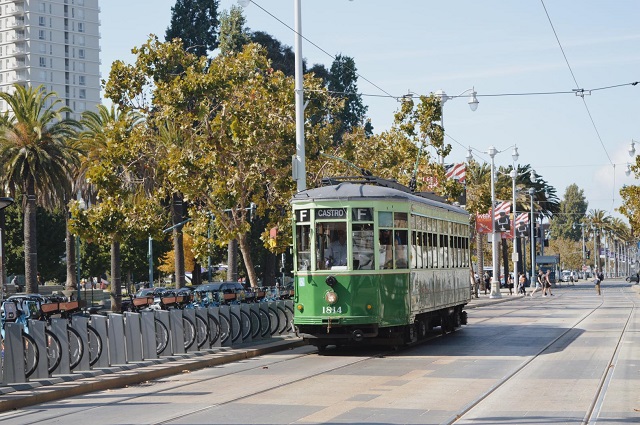
The Infrastructure Investment and Jobs Act, also known as the Bipartisan Infrastructure Law, offers U.S. states and cities the chance to invest in transportation systems that modernize infrastructure, expand access and mobility for all people in a community, improve public health and safety, and boost local economies.
Transportation emits more climate-warming greenhouse gases than any other sector in the United States, so cutting carbon from transport is also essential to achieving the ambitious goal of reducing emissions 50%-52% by 2030. Recent modeling from America Is All In, a coalition of state and local climate leaders, shows that emissions reductions in the transportation sector can contribute more than one-third of what’s needed to reach the 2030 U.S. climate goal.
The key is to go multi-modal: not just cars, buses, rail, bicycles or walking, but a coordinated system of various modes of transportation. States, tribes, cities, universities and businesses have vital roles to play in developing clean multi-modal transportation systems that work for the entire community while fostering health, safety and economic prosperity.
Now, a new paper from America Is All In shows how communities can benefit from the low-carbon multi-modal approach.

Why Multi-modal Transport Is a Good Investment for Cities
Clean multi-modal systems can provide safe, equitable, comfortable, convenient, accessible transportation, including mass transit, walking, biking, micromobility (such as electric scooters and bikes and shared bicycles) along with car use.
Most U.S. cities depend on cars to get around and design their communities accordingly. But that sidelines and endangers the roughly 20% – 40% of residents in a given community who either can’t or shouldn’t drive, due to factors such as economic limitations, age constraints and disabilities. America’s underfunded public transit systems are frequently unreliable, time-consuming and unpleasant to ride, making it difficult and inefficient for people to reach jobs or other necessary destinations. Car dependency imposes serious risk to non-drivers, as needing to walk or bike on roads designed for cars all too often causes injuries and deaths. Expanded multi-modal transportation options make roads safer for all travelers and increase access to economic opportunity, getting non-drivers to jobs, businesses and other locations that are virtually out of reach without a car.
In addition to addressing the inequities of car dependency, multi-modal transportation can provide a suite of community health and livability benefits, including better air quality and reduced noise pollution, some of the largest environmental causes of health issues. Fewer cars on the road and improved road and vehicle design means fewer crashes for those inside and outside of vehicles. And active modes of transportation can improve physical and mental health by helping more Americans exercise.
Despite these benefits, the Bipartisan Infrastructure Law funds might be used to further entrench car dependency. For example, highway expansions reinforce car dependency (and don’t even alleviate traffic) and perpetuate the unequal health and safety impacts of many car-centered systems. Importantly, if Bipartisan Infrastructure Law investments are primarily directed towards expansion of America’s roads, funding could result in an increase in emissions instead of much-needed reductions.
Alternatively, communities can choose to use Bipartisan Infrastructure Law funds to modernize transportation systems, improve equity, and reap a host of health, safety and economic benefits by building multi-modal transportation systems.
The 15-minute Communities Approach
In denser urban areas, an important element of low-carbon multi-modal transportation systems is building so-called “15-minute communities,” where basic needs like good schools and fresh foods are within a 15-minute walk or bike ride. Past these basic needs, community members can reach more distant destinations with quality public transit accompanied by the necessary infrastructure to walk, bike or use micro-mobility options when getting to and from mass transit stations.
In rural communities, walking and biking are often unfeasible and mass transit cannot operate frequently enough to reasonably meet transportation needs, so appropriate transportation systems in rural spaces will likely require personal vehicle use. To cut emissions and improve air quality, it will be necessary to shift usage of fossil-fueled vehicles in rural areas towards electric vehicles (EVs). Continued car use must be made safer with strategies like reducing vehicle speeds in high-risk areas and taking a Safe System approach, which places the responsibility for safe roads on transportation design. For rural residents who can’t drive, options like on-demand shuttles could expand mobility.
The Health, Safety and Economic Benefits of Multi-modal Transportation Systems
Health
Poor air quality is the greatest environmental health risk factor in the United States, resulting in 100,000–200,000 excess deaths per year. Air pollution disproportionately harms low-income communities, minorities and young children; reducing pollution addresses current and historic inequities.
Air quality can be significantly improved by shifting to low-carbon multi-modal transportation systems. Better air quality improves student academic performance, reduces premature births, alleviates respiratory and other conditions, reduces cardiovascular illness, reduces the risk of dementia and Alzheimer’s disease, and results in fewer clinic visits and hospitalizations.
Shifting towards multi-modal transportation systems can also alleviate noise pollution. More than 100 million Americans are exposed to continuous noise pollution above the EPA’s recommended level to avoid hearing loss, with tens of millions more potentially at risk for heart disease and other noise-related health effects. Other health problem associated with noise pollution include sleep disruption, stress and annoyance.
Additionally, only half of Americans meet the guideline for recommended aerobic physical activity, and that group is disproportionately male, younger, well-educated and White or Asian. Active modes of transportation like walking and biking increase physical activity, which provides health benefits like reduced risk of chronic disease and improvement of existing chronic disease; a 12% reduction in mortality; and an 11% reduction in cardiovascular disease. Increased physical activity also improves mental health. Exercise is comparable to antidepressants and psychotherapy for treating depression, and research suggests that physical activity protects against anxiety symptoms and disorders.
Safety
In car-dependent transportation systems, roads are dangerous for pedestrians and bicyclists. A pedestrian is killed by a vehicle every 85 minutes in the United States, and fatal pedestrian injury is a leading cause of death for children. If pedestrians or bicyclists survive a traffic collision, the ability to recover from these injuries is inequitable, as there is racial inequality in accessing healthcare to recover from injuries.
Driving is also dangerous for people riding in cars: In 2019, more than 22,000 passenger vehicle occupants died in traffic crashes and 2.4 million passenger vehicle occupants were injured, according to the National Highway and Traffic Safety Administration. Car crashes are the second-leading cause of death for teenagers in the United States.
Safer roads can prevent many of these unnecessary deaths. In particular, a strategy known as Complete Streets can avoid injuries and fatalities by ensuring safe and sufficient accommodation for all travelers on a street, including pedestrians, bicyclists, public transportation users and drivers. A study of 37 Complete Streets projects in the United States found that the projects pay for themselves in fewer than eight years by avoiding substantial collision and injury costs. Similarly, a study of 53 countries found that a Safe System approach — which takes into account the way that design, infrastructure and systemic issues influence road safety — achieves the lowest rates of road death fatalities by population. In addition to improving road safety, automakers have a key role to play in designing cars to be safer, while cities can incentivize the use of smaller vehicles, which are safer for people outside of the vehicle during a crash.
Economy
Expanded access to transportation brings more access to economic opportunity. Where people live is often far from where they work. Increasing access to low-cost transportation can connect people to higher-wage jobs as well as service jobs in areas that are difficult to access without a car, particularly benefiting people who spend higher portions of their income on transit. Multi-modal transportation options also expand the labor force available to businesses.
In addition to accessing high-quality jobs, multi-modal transportation can reduce the length and stress of commutes. Among the nation’s 100 largest metropolitan areas, only 27% of the workforce can access a typical job by transit in 90 minutes or less. Research shows that shorter commute times are a significant predictor of upward economic mobility. Better and shorter commutes can also reduce stress, health complaints and absenteeism from work while also improving sleep.
Investments in public transportation and other amenities are generally found to drive up housing costs, but reallocating the land used for parking lots and roads can free up more space for new development of less expensive housing. Addressing restrictive zoning regulations can make the best and most equitable use of this available land. For example, restrictive zoning regulations and taxes drive up home prices by anywhere from $50,000 in Boston to $400,000 in the San Francisco Bay Area. And expensive and wasteful minimum parking requirements that force building developers to build large amounts of parking need to stop.
Finally, while EVs have a higher upfront cost, they require 50% less maintenance than traditional internal combustion vehicles, and can lower fuel costs by $4,700 or more over the first seven years of ownership. Most EVs are now cheaper to own on a monthly basis as soon as they are driven off the lot compared to gas-powered counterparts. As recent gasoline price spikes have made clear, drivers can also benefit by avoiding the volatility of gasoline prices.
Designing Equitable Transportation Systems
No single mode of transportation will result in an equitable outcome by itself. This means that decision-makers must be attentive to the diverse needs and challenges of all community members.
For example, buses are a key strategy to improve equitable access to transportation, but how investments in buses are designed matters. For a bus system to be truly equitable, all transit riders must be able to safely walk, wheel, bike or use micro-mobility options to and from the bus stop. This means that sidewalks and bike infrastructure must safely connect the community to the bus stop. Infrastructure such as streetlights are essential for pedestrians, especially women and members of the LGBTQ+ community, to feel safe while walking alone at night to and from the bus stop. Ramps at the bus stop and the accompanying sidewalks must be present for wheelchair users or parents with strollers.
Policing must not present risk to minority transit users, especially Black transit users who disproportionately face overly aggressive police enforcement and brutality in transit environments.
Progressive fare design, such as fare-capping, can make sure that low-income people don’t pay more than wealthier transit riders who can afford the upfront cost of discounted monthly passes. Payment systems must ensure that any traveler, regardless of whether they have a smartphone or bank, can easily pay for the bus. Some U.S. cities are even implementing fare-free transit, which can offer benefits to cities and transit riders alike.
Non-federal leaders should take advantage of the new Bipartisan Infrastructure Law funding to modernize local transportation systems and put their communities on the path towards an equitable, clean, multi-modal future. In doing so, they can realize climate, health, safety, economic and equity benefits for communities across America.
This article was originally published on WRI’s Insights.
Liz Bridgwater is a Research Analyst II for the U.S. Climate team at World Resources Institute.
Sujata Rajpurohit is an Associate with World Resources Institute, United States.
Kevin Kennedy is a Senior Fellow for the U.S. Climate Initiative at World Resources Institute.
Matt Herbert is the Communications Manager for Climate at World Resources Institute, United States.





